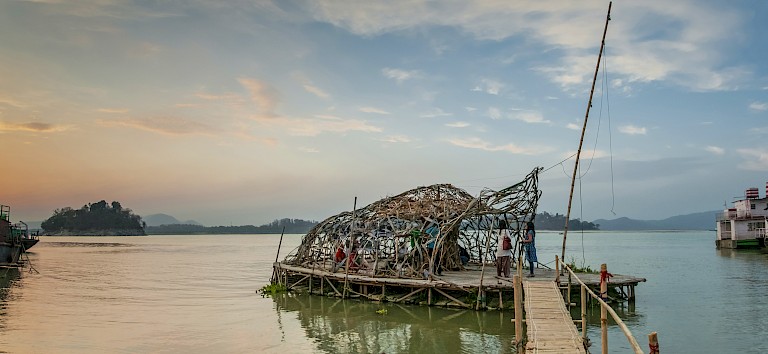



The raft structure in its anchored state became a presentation space and a platform for hybrid projects focusing on the interface of art, environment, culture and vernacular crafts. This public art intervention fostered creative engagement by the community and created a sense of place. A loose collective of local artists, artisans, writers, performers, designers, filmmakers, teachers and environmentalists has emerged out of this project. A range of initiatives were structured over one year of programmed activities, engaging with artistic, cultural and environmental issues - in an open interactive format in the public space of the river and riverfront. Some of the initiatives include but were not limited to are listed below. The future stage of Cultural Re-imaginations seeks to put a structure in place for continuing initiatives.
- Stimulated exchange between the local artistic/artisanal community and the publics, through a series of imaginative and unconventional initiatives. Combined riparian journeys, performance, visual and installation art, storytelling, adda (informal conversations), experimental sounds, music, humour and lectures to create thought-provoking events, spaces and experiences.
- Activated and enlivened the riverfront, beyond the bamboo raft, drawing inspiration from the river & its folklore and brought together local arts colleges, organizations and artist’ collectives to create collaborative work in the city in the dynamic space of the river.
- Launched temporary art initiatives that activated public spaces along the riverfront creating new ways of relating/encountering/experiencing the environment and initiatives that got artists and audience members to care more about the condition of the river and having conversations making our waterfronts safe and public spaces more accessible and active.
- Engaged local artists, artisans, environmentalists, designers and art students from the Guwahati Artists’ Guild, Assam Fine Arts and Craft Society, Cotton College, State Art and Craft College and Indian Institute of Technology (IIT) in Guwahati.
In regards to the art scene in the country, the project endeavored to raise environmental awareness in the Northeast India and beyond - using the floating space of the bamboo raft as a presentation space and as a platform for experimental projects that focused on the interface of visual arts, vernacular crafts and the environment. The project endeavored to create new interdisciplinary convergences that cut across the traditional boundaries of art, architecture and social science disciplines and practice. The initiatives and journeys undertaken opened up new possibilities - expanding the ways of reading and understanding the river and the city, of habitats that humans and other species build (or not) - opening up conversations about making better places that lead to better lives.
All three stages of the project were provocations to think through the intersections of fluid 'social' and 'natural' landscapes. The project attempted to transcend the idea that the environment is a static entity that ought to be preserved; instead envisioning it is as a dynamic set of relationships. The project galvanized a diverse group of practitioners, scholars and community members to conceptualize and creatively engage with current environmental issues; within a poetically framed engagement with sustainability, habitats transformation and the impending global climate crisis enveloping us all.
As a piece of public art, the raft while being constructed at the village of Rampur and then at the riverfront in the city, was able to establish a censor-free means of contact with viewers and the community. Viewers, visitors and passersby used the raft-in-progress and the completed raft as a resting space, for enjoying the river-scape, community gatherings, impromptu music concerts and as a landmark for creating photographic memories – generating alternate ways of interacting with the river. The bamboo raft spontaneously became a point of intersection of organic social spaces and a series of complex network of social, economic, cultural and ecological activities intrinsic to everyday life at the riverfront. The raft was completely non-motorized and powered by the wind - i.e. bamboo and wooden oars and rudders and cloth sails were crafted for use during the journeys and for moving the raft.
Throughout the process of building and installation at the riverfront, general public, commuters en route to across the river and other towns and villages along the river and the in-house community at the Department of Inland Water Transport (IWT) engaged with the artisanal community and the artist in spontaneous conversations. IWT went on to launch an experimental effort at creating an all bamboo, environmentally sustainable water vehicle, to ferry people on the river modeled after the raft structure of this project. The installations and initiatives encouraged publics who experienced them, to think critically about their cultural capital.
A community of artists, artisans, architects, writers, folklorists, designers, filmmakers, media practitioners and boatmen converged on the raft during it’s anchored state as well during the riparian journeys, engaging in performances that ranged from storytelling, movement art, drawing, experimental and folk music to informal conversations. Participants expressed that the initiatives and the collective journeys were a process of re-imagining their relationship with the environment and the urban spaces of the city.




